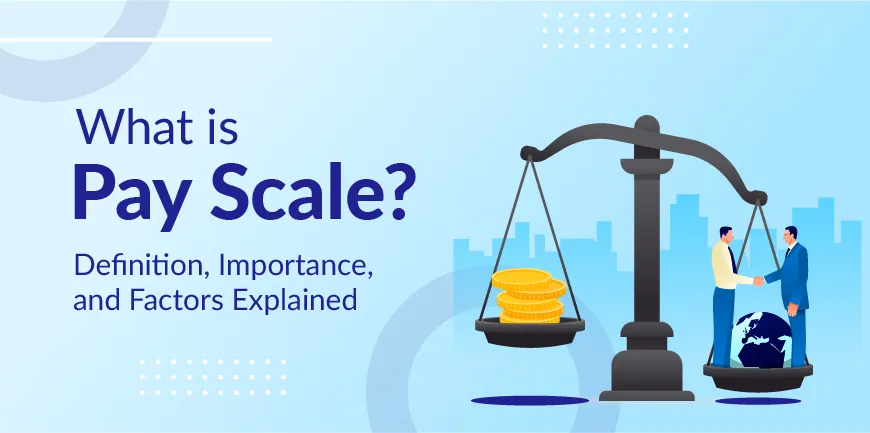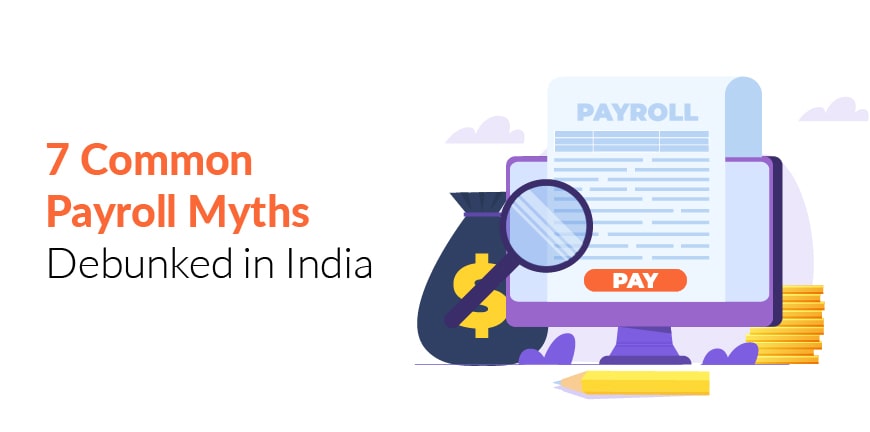
10 Proven Recruiting Strategies to Attract Top Talent
19/09/2025
What is Employee Engagement and How to Boost It in 2025?
22/09/2025- What is a PayScale? Meaning and Definition
- Why is understanding PayScale important?
- What Are the Main Types of Pay Scale?
- What are the Benefits of Understanding PayScale for Employees
- How is Pay Scale determined?
- What Is the Difference Between Pay Scale and Pay Grade?
- What are the Factors that influence PayScale?
- What are the Challenges Related to Pay Scale?
- Conclusion
- FAQs- Frequently Asked Questions
Do you wonder what your skills, experience, or even your job itself is worth? PayScale can help you understand. It provides clarity to employees regarding how they deserve to be compensated. Whether negotiating a new job offer or ensuring the team members are being paid fairly, PayScale offers you the data you need to make informed compensation decisions. This Pay scale guide outlines the various options available and can help you make the right decision for your organisation.
What is a PayScale? Meaning and Definition
A PayScale is a system that determines how an employee must be paid for their work, based on factors like the employee’s level, rank or status within the organisation, duration of employment and the level of complexity of work they are responsible for. Private organisations use salary structures with grades (including minimums, midpoints, and maximums) to define the pay ranges available to employees in each grade/range.
Why is understanding PayScale important?
The competitive business environment requires that everyone is familiar with and understands PayScale. And by everyone, we mean both those who are employed and those who employ. Employers must be aware of pay scales so that they can allocate the right amount of the company’s budget for employee compensation, attract the right talent, and reduce wage gaps. Employees must know of it so that they understand how valuable their job roles are and what the proper compensation is. It also helps them manage their finances effectively. All of this can be done effectively by understanding PayScale and using the insights and data it provides.
What Are the Main Types of Pay Scale?
There are three main types of pay scales or pay structures: traditional, Broadband, and Market-based pay scales. The concept can be better understood with examples.
1. Traditional/individual pay scales
A traditional pay scale is one of the most common types of pay scales. Here, the salary ranges are divided into multiple narrow pay grades. This is based on the type of role and seniority level. Set increments are given at fixed intervals. This is rewarding for individuals who want to work for more extended periods in a company and progress in their roles as they gain more experience. Here is a scale of pay example:
A company has pay grades for its sales team:
- Grade 1 (Entry Sales Associate): ₹25,000–₹30,000 per month
- Grade 2 (Senior Sales Associate): ₹30,001–₹36,000
- Grade 3 (Sales Manager): ₹36,001–₹42,000
Each grade is accompanied by clear criteria for advancement and has set yearly increments.
2. Broadband PayScale
In the broadband pay scale, job roles are grouped into fewer, wider pay bands, which cover a broader salary range. This means there are more chances of higher salary increases. This is often used for career growth or to move employees across teams. However, there is less control over the exact pay differences between similar or the same roles.
Example: A tech firm has a single pay band for all developers. The range is from 60,000 to 1,20,000 per month. This pay band covers junior, mid-level, and senior developers. Their pay depends on their experience or other valuable contributions.
3. Market-based PayScale
The salary ranges for employees are in line with the current industry data and market rates for identical jobs. Pay grades and ranges are determined by assessing and identifying what competitors are paying for each role. This offers transparency and competitiveness.
Example: A hospital that is conducting market analysis offers-
- Paediatric nurse: 60,000 to 1,00,000 a month
- Pharmacist: 50,000 to 80,000
These ranges indicate payments made to individuals for similar jobs in the broader market. According to the same, these ranges may be adjusted to attract the right talent and stay competitive.
4. Other Structures
- Step Pay
Employees are eligible for annual salary increments or upon achieving a specific milestone. Government sectors and educational institutions follow this pay scale.
Example: If a teacher starts at a salary of 20,000, that is step 1. After a year, they receive an increment and earn 22,000, and so on.
- Job family structure
Jobs are grouped by functional fields, such as engineering and marketing, and each of these areas has its own set of pay grades.
Example: Engineering job family: Intern, junior engineer, senior engineer, and lead engineer —all with distinct and unique ranges.
What are the Benefits of Understanding PayScale for Employees
Understanding PayScale can help employees gauge the value of their job role in the market.
1. Enhanced trust
Knowing if an organisation is paying you fairly is one of the most considerable doubts you may have when you are working in a specific job role. This uncertainty can be cleared by having an understanding of the pay scale.
2. Ensures fair pay
Pay scales make sure that employees working in the same or similar positions with similar skills are compensated fairly. This reduces wage gaps and promotes equity.
3. Can plan their career progression
Understanding pay grades and their career progression paths allows individuals to set goals for growth and gives them the confidence to ask for salary increments.
4. Management of finances
Employees can manage their finances more effectively if they have a clear understanding of their current job’s earning potential. They also get an idea of how their career can progress with the company.
5. Motivation to stay in their current jobs
When employees understand that their pay scale is fair, it automatically encourages them to perform better and develop skills. It increases their job satisfaction, and these employees are less likely to leave the organisation.
How is Pay Scale determined?
The pay scale is determined based on various factors, including the demand for the job role, the employee’s experience level, and market pay rates. And employers have the right to decide how much they pay their employees based on these factors. However, the pay must align with the salary range for that role.
1. Data from market surveys
Employers share data regarding the salaries they are paying employees for similar positions in similar industries. This is considered a significant contribution to market pay studies.
2. Demographic and market factors
Employee salaries are based on various factors, including demographic and market considerations. This includes the availability of jobs, the availability of candidates for those jobs, or the number of employees seeking the same education and skills.
3. Fair Compensation
Bigger organisations determine the salary to be paid by assessing the relationship between different jobs, skills, and experience required to perform each job. This ensures that they are paid fairly.
4. Budget availability and allocation
Every company has its own budget constraints, and it typically sets aside a specific amount after determining the budget available for each role.
What Is the Difference Between Pay Scale and Pay Grade?
A PayScale is a system that determines how an employee must be paid for their work, based on factors like the employee’s level, rank, or status within the organisation, duration of employment, and the level of complexity of work they are responsible for. Private organisations use salary structures with grades (including minimums, midpoints, and maximums) to define the pay ranges available to employees in each grade/range.
A pay grade refers to a specific category or level within a pay scale that groups jobs of similar value or responsibilities. Each pay grade has a defined salary range or fixed salary amount associated with it. Employees who come under a certain pay grade receive compensation within the limits of that grade. This clarifies the exact compensation to be made to employees and often has multiple steps or levels, reflecting seniority or experience.
| Aspect | Pay Scale | Pay Grade |
| Definition | A broad salary structure defining salary ranges based on job factors | A specific level or category within the pay scale with defined salary limits |
| Purpose | Defines overall salary framework and growth path | Groups jobs by value/responsibility and sets the exact pay range |
| Salary Flexibility | Provides range from minimum to maximum for a job level | Predetermined fixed levels or steps within a grade |
| Scope | Covers multiple grades or salary bands | A component within the pay scale classification |
What are the Factors that influence PayScale?
Several factors can influence an employee’s compensation. Companies often have a set of standards that help them assign fair compensation to both new and existing employees. This also helps employees understand the company’s hierarchy and provides a sense of satisfaction regarding the wages they receive.
1. Industry-specific
Every industry has different service and product needs. This, however, also determines the need for employees and their specific skills. For high-demand services, services that require deeper knowledge and education, or production that requires greater skills, workers are paid more.
2. Experience in a particular field
If a professional has been working in the same field for a long time, they obviously have more advanced experience. These types of employees are considered highly valuable due to their exceptional skills. Additionally, their experience serves as a support system for less-experienced coworkers.
3. Responsibility levels
With more experience comes more responsibilities. A fresher in a company has a lot less responsibility than someone with 15 years of experience. Naturally, the fresher will be paid a lot less as well. The experienced worker is likely to transition into a leadership role due to their expertise and the trust they have earned over time.
4. Educational Background
Of course, skills are given priority in today’s time. However, educational qualification is still given a lot of importance. It plays a crucial role in earning a higher salary. An advanced educational degree can help you move up in the same company, as well as differentiate you from others in the same role.
5. Advanced training and certifications
No matter the number of degrees or skills you have, other relevant certifications, and taking up courses can make you valuable to an organisation. Why? Upskilling is extremely important in today’s competitive business environment. This also shows an employee’s interest in continuous learning and commitment to work.
What are the Challenges Related to Pay Scale?
PayScale challenges affect employee motivation, retention rates, and fairness in organisations.
1. Internal equity and pay disparity
Making sure that employees in similar roles with the same level of experience are paid fairly is challenging. Inconsistent pay can lead to reduced employee loyalty and early exits. The main cause of this inconsistency is often due to improper performance evaluations or unreliable pay structures.
2. Transparency and communication issues
Failing to inform employees of their pay policies properly can create chaos and erode trust among employees. Why? Because employees don’t understand the basis on which they are being paid, it leads them to think the employer is being unfair.
3. Benchmarking and competitive fairness
Even with market data available, organizations often struggle to benchmark salaries accurately. The reason for this is that there are numerous distinct roles and changing industry standards, making benchmarking more complicated. This even leads to misleading salary expectations.
4. Stringent salary structures
While fixed salary bands do help maintain a specific stability, they fail to adapt to changes in job market demands and often do not reward employees who excel with proper benefits. This hurts recruitment and retention.
5. Balancing fixed and performance pay
While you may be compensating your employee well, it’s also essential to ensure they are provided with the right incentives as per their performance. However, having a performance standard against which you pay them is not feasible because the nature and complexity of work vary across different roles.
6. Legal and regulatory compliance
Pay structures must comply with relevant labour laws, tax regulations, and standards. However, ensuring that pay scales are designed in such a way is the problem.
7. Budget constraints
Ensuring that employees receive competitive and fair compensation while staying within budget is almost impossible.
Conclusion
Pay scales vary based on industry, company vision, and the current payment system. The right pay structure for your business depends on a wide range of factors, including budget allocation, market survey, demographics, etc.
With over 30 years of experience in HR, the Alp Consulting team has extensive expertise in designing reward schemes and payment structures for businesses operating across various sectors.
If you are unsure about which payment scheme is right for your organisation, our professional guidance can help in implementing the right one. Get in touch with our team today.
FAQs- Frequently Asked Questions
1. What is meant by Pay Scale?
A PayScale is either a system that determines how an employee must be paid for their work, based on factors like the employee’s level, rank or status within the organisation, duration of employment and the level of complexity of work they are responsible for.
2. What is the difference between a pay scale and a salary structure?
A pay scale defines the salary range (minimum, maximum, and increments) for a specific position or job family, while a salary structure is the overarching framework that organizes all positions into pay grades and includes the various components of compensation, such as base pay, allowances, and bonuses.
3. Why is PayScale important in HR?
Pay scale in HRM is crucial as it helps in attracting the right talent, motivates employees to perform better and ensures legal compliance.
4. Can employees negotiate PayScale?
Employees can negotiate pay scale as long as they know how much their skills, experience are worth and the value they bring to the company. Employees must also know about their market value, have their accomplishments on paper and prepare a strong pitch before they can negotiate.
5. What factors affect pay scales?
Factors like the type of industry, individual organization, experience, responsibilities, education, training and certifications can affect pay scales.
6. What is the role of pay scale in promotion?
Pay scales influence promotions by defining the hierarchical progression of jobs and the corresponding salary increases that reflect greater responsibility and authority.
7. How does pay scale vary across industries?
Pay scales vary across industries due to differing market demand for skills, the specific value a role brings to a company, the financial resources and profitability of the industry, and the overall cost of labor in the relevant marketplace.
8. Is pay scale the same as CTC?
a pay scale defines a range of salaries for a specific job level or grade, while CTC is the total cost an employer incurs for hiring and employing an individual, encompassing their gross salary, bonuses, benefits, and employer contributions.
Contact Us For Business Enquiry

Yugandhara V. M
Yugandhara V. M serves as the Assistant Vice President – HRO at Alp Consulting Ltd., bringing over 14 years of rich experience in Human Resource Outsourcing, payroll management, and statutory compliance. He specializes in driving process excellence across HR operations, ensuring seamless service delivery and compliance with labor laws. Yugandhara’s expertise lies in managing large-scale client engagements, optimizing HR processes, and implementing efficient workforce management systems that enhance organizational performance. He also leads comprehensive payroll services, ensuring accuracy, timeliness, and compliance for diverse client portfolios.




